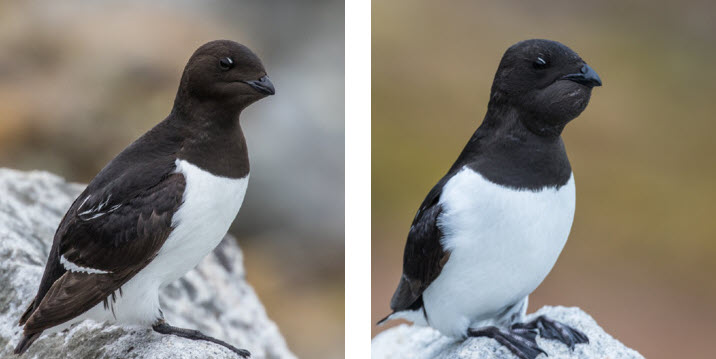David M. Larson

Left: Dovekie with empty gular pouch. Right: Dovekie with full gular pouch. Photographs by the author.
A couple of years ago, I was one of the guides on a cruise in the Svalbard archipelago, Norway. Most of the passengers were there for the polar bears, but we did visit breeding colonies of alcids. While comfortably seated on a boulder in a Dovekie (Alle alle) colony of perhaps 1,000,000 birds at Magdalenefjord, I had time to enjoy the antics of the birds and photograph their comings and goings. Many of the birds arrived in the colony with bulging necks full of food for the young in the nests below the rocks. I knew that Dovekies are planktivorous, feeding especially on Calanus copepods. How many of these tiny zooplankters were they bringing to their young? And how did they catch all those copepods?
Dovekies were presumed to catch copepods by raptorial feeding, watching for and then seizing prey in individual attacks. That seems impractical considering the relative size of their prey, nutritional content, and the numbers required for feeding chicks. Several of the largest ocean planktivores—baleen whales and three shark species—consume large numbers of prey by filter feeding—taking in large volumes of water containing prey and then expelling the water while retaining the prey. In seabirds, Broad-billed Prions (Pachyptila vittata) have been seen filter feeding at the surface, and this species has bill adaptations for this style of feeding. Harding, et al. (2009), suggested, based on metabolic data, that Dovekies would need to capture a staggering total of almost 60,000 copepods per day to satisfy the caloric needs of themselves and their chicks. That would imply capturing six copepods per second while underwater.
In a recent study by Enstipp, et al. (2018), the researchers tested the hypothesis that Dovekies engaged in filter feeding in order to collect that many prey items. Dovekies were captured at a colony in Svalbard, brought to a 5.5 x 2.7m (1.2m deep) tank at the Ny-Ålesund research station, and recorded by video during subsurface feeding on different concentrations of copepods (450-8300/m3). At no time and at no concentration of copepods did any of the Dovekies employ filter feeding to acquire prey in this environment. Instead, the birds engaged in suction feeding. As shown on their videos, all of the birds detected and swam close to individual copepods, made a head strike (lunge) to within a few centimeters of the prey, opened the bill slightly while suppressing the gular pouch to draw in the copepod, closed the bill, and then expelled the excess water. The typical time interval for capture, from opening to closing the bill, was 40–80 milliseconds. While foraging underwater, the Dovekies captured an average of 1.35 copepods per second, nowhere near the six per second suggested by Harding, et al.
There are, of course, several caveats to the authors' conclusions about feeding rate. First, these studies were carried out in a shallow, well-lit tank, not the open ocean. However, Arctic waters are typically clear, and Dovekies do not dive very deep, 10 meters on average. Second, while the densities of copepods in this study were within the average range at sea, the distribution was uniform. Distribution at sea could feature much higher prey densities due to concentration by hydrographic or other factors, allowing for filter feeding under some conditions. Indeed, the authors suggest that there could be a threshold concentration that triggers a shift to filter feeding—a concentration beyond what they could achieve in the pool. Nevertheless, the lack of any morphological adaptations for filter feeding, such as the palatal lamellae along the edges of the beak of Broad-billed Prions, make it unclear exactly how filter feeding would be accomplished in Dovekies.
So, how is it possible to reconcile the suggestion of 60,000 copepods per day and a capture rate of only just over one per second? If the Dovekies are devoted suction feeders, and do not switch to filter feeding, then it is unlikely that the 60,000 figure is correct. Indeed, Harding, et al., do allow that that number could be an over-estimate.
Enstipp, et al., noted that 60,000 copepods would be 35 food deliveries per day. Those numbers give me an estimate of the capacity of the gular pouch at around 1700 copepods. Thus, my questions from that rock at Alkekongen next to Magdalenefjord were answered.
References:
- Enstipp, M.R., S. Descamps, J. Fort, and D. Grémillet. 2018. Almost like a whale—first evidence of suction feeding in a seabird. Journal of Experimental Biology 221 (13) jeb 182170. doi: 10.1242/jeb.182170.
- Harding, A.M.A., C. Egevang, W. Walkusz, F. Merkel, S. Blanc, and D. Grémillet. 2009. Estimating prey capture rates of a planktivorous seabird, the Little Auk (Alle alle), using diet, diving behavior, and energy consumption. Polar Biology 32 (5): 785-796.
David M. Larson, PhD, is the Science and Education Coordinator at Mass Audubon's Joppa Flats Education Center in Newburyport, the Director of Mass Audubon's Birder's Certificate Program and the Certificate Program in Bird Ecology (a course for naturalist guides in Belize), a domestic and international tour leader, and a member of the editorial staff of Bird Observer.